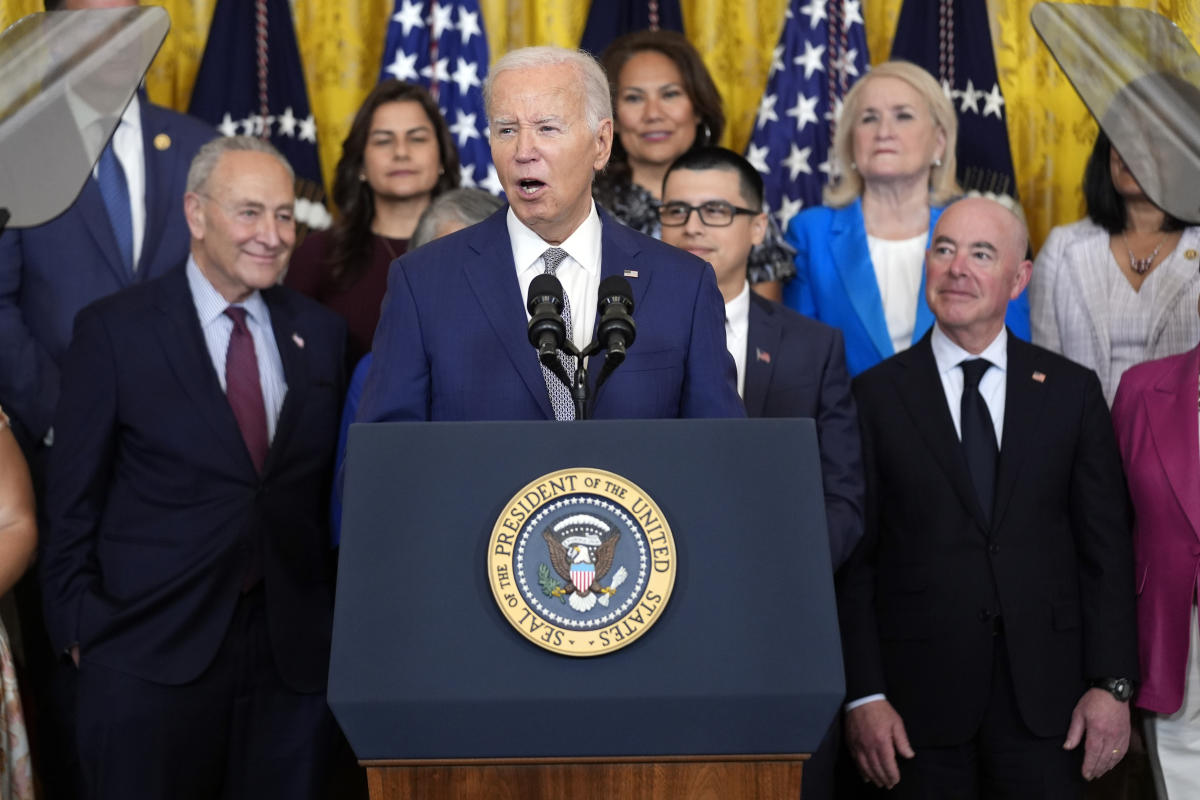WASHINGTON (AP) — A new Biden administration policy announced Tuesday will give about half a million immigrants who are married to U.S. citizens but have no legal status in the United States a path to citizenship for them and their children .
It is one of President Joe Biden’s most sweeping immigration policies and one that immigrant advocates have lobbied the administration heavily for.
A look at the new policy, who could benefit from it and how:
How did things work before?
Under U.S. immigration law, if an American marries someone who is not a citizen but lives in the United States, it can be a simple process for the spouse to apply for long-term permanent residency – called a green card.
But if the spouse has been living in the United States illegally for a long time, that process becomes much more complicated.
They often have to leave and apply from their home country. Depending on how long the person has lived in the U.S. without permission, they may have to stay abroad for three to 10 years before they can apply to come back. They can apply for an exemption to avoid having to wait so long abroad, but receiving an exemption also takes an average of about three and a half years.
They must go abroad, apply to a consulate – where wait times can be long – and be allowed back into the US
“There is the risk of prolonged separation, especially if something goes wrong,” said Elizabeth Taufa, policy attorney and strategist for the Immigrant Legal Resource Center.
Faced with the prospect of leaving their families in America for a lengthy trial that may not work, many decide to stay and live in the shadows.
How will Biden change immigration policy?
Under the new policy, many spouses without legal status can now apply for lawful permanent residence without leaving the U.S. and ultimately have a path to citizenship. But it’s not a blanket endorsement.
To qualify, people must have lived in the US for at least 10 years, not pose a security risk and be married before June 17, 2024. They must apply to the Department of Homeland Security, which will process applications based on the application. on a case-by-case basis, the department wrote a fact sheet describing the new policy. Spouses of immigrants cannot have previously been admitted to the country or released on parole.
Applicants will be vetted for prior immigration history, criminal history and more, including possible fraud, Biden’s announcement said.
Once Homeland Security approves an application, the White House said, the person has three years to apply for permanent residency and can obtain a work permit for up to three years.
According to immigration organization FWD.us, approximately 1.1 million immigrants without legal status in the United States are married to U.S. citizens. The government believes that eventually about half that number – about 500,000 – could qualify for this program, plus about 50,000 of their children.
On average, the spouses have lived in the United States for just over 20 years, the White House said. A senior administration official said on a call to reporters that they expect the majority of people benefiting from the program to come from Mexico.
How does this fit in with Biden’s other immigration policies?
The Biden administration has pursued a two-pronged strategy on immigration and border security over the past year and a half.
On the one hand, Biden has made it much harder to qualify for asylum at the southern border and intensified removals of those ineligible to stay. Immigration advocates have vilified Biden’s decision this month to halt the asylum process after arrivals at the southern border reached a certain number per day.
On the other hand, the government has taken a number of steps to allow people into the country.
In the biggest example, the government last year created a program allowing people from Cuba, Haiti, Nicaragua and Venezuela to come to the U.S. if they have a financial sponsor, pass a background check and fly into a U.S. airport. At the end of April, 434,800 people from these four countries arrived through that program.
Many advocates have pushed the administration to do more for immigrants who have lived in the U.S. illegally for decades.
What will change in the program for ‘Dreamers’?
Separately from the policy for migrant spouses, the government also announced changes aimed at helping those in the Deferred Action for Childhood Arrivals program more easily qualify for long-standing work visas.
The Obama administration in 2012 offered people brought to the U.S. illegally by their parents protection from deportation and temporary work permits. Many of them, also known as ‘dreamers’, are now parents themselves.
Many companies that employ DACA recipients can apply for work visas for them, which is more stable and provides a path to permanent residency, said Dan Berger, an immigration fellow at Cornell Law School and co-founder of Path2Papers, an organization that helps dreamers aspire to work visas and other ways to obtain legal permanent residence.
But to get the work visa, the DACA recipient must travel abroad, apply and obtain a waiver to reenter the US. Berger said the waiver process is very slow and offers little guidance, so employers and DACA recipients are not eager to try it.
“Having clear guidelines and clear expectations is very helpful,” he said.
What’s next?
The Department of Homeland Security should establish guidelines on how the marriage program will work. A senior administration official said they expect the program to start accepting applications by the end of the summer.
It will be up to US Citizenship and Immigration Services, an agency within the Department of Homeland Security, to process all applications. That agency has historically struggled with funding as it works to reduce backlogs and wait times.
Republicans and immigration opponents have intensely criticized the proposal, and opponents will almost certainly file a lawsuit in an attempt to stop it.






